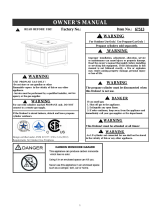
•
•
•
•
•1
2
3
•
•
•
•
•
•
•
•
•
•
•
•
•
•
•
•
•
•
•
•
•
•
•
•
Chercher de l’aide auprès de votre fournisseur de gaz /ou du service d'incendie.
Ne pas essayer de corriger le problème vous-même.
Couper l’alimentation en gaz et vous écarter immédiatement de la bouteille de gaz et du foyer d’extérieur.
N’entreposez jamais la bouteille de GPL où la température peut dépasser 125°F (52°C).
Gardez l’appareil à gaz à l’écart d’un lieu où il pourrait devenir excessivement humide. N’utilisez pas l’appareil à gaz si une partie a
été submergée. Appelez immédiatement un technicien d’entretien qualifié afin qu'il inspecte l'appareil et qu'il remplace toute pièce du
système de commande ou toute commande du gaz ayant été submergée.
La pression d’alimentation maximale pour cet appareil d’extérieur est de 14 po de colonne d’eau.
La bouteille de GPL utilisée doit comporter une bague de protection du robinet.
La bouteille de GPL doit être munie d’un dispositif homologué de protection contre le remplissage excessif et un raccord de bouteille
de GPL QCCI ou de Type 1 (CGA810).
Assurez-vous d’utiliser uniquement une bouteille de gaz propane liquide (GPL) de 20 lb (9,1 kg) avec un robinet du Type 1
N’entreposez jamais une bouteille de GPL remplie dans une voiture chaude ou son coffre. La chaleur entraînera une augmentation de
la pression de gaz, ce qui pourrait faire ouvrir la soupape de décharge et permettre au gaz de s’échapper.
Il faut remplacer tout revêtement de protection ou autre dispositif de sécurité enlevé pour l’entretien de l’appareil avant de faire
fonctionner cet appareil.
On ne doit pas laisser tomber la bouteille de GPL ni la manipuler avec rudesse.
Transportez et entreposez les bouteilles de gaz vides soigneusement et correctement. Il faut entreposer les bouteilles à l’extérieur dans
un endroit bien aéré hors de la portée des enfants.
avec cet appareil selon les exigences de l’American National Standards Institute (ANSI) et le Comité directeur de l’Association
canadienne de normalisation.
L’appareil doit être inspecté par un technicien d'entretien qualifié avant l’usage et au moins une fois par an.
L’installation et la réparation doivent se faire par un technicien d'entretien qualifié. L’appareil doit être inspecté par un technicien
d'entretien qualifié avant l’usage et au moins une fois par an. Un nettoyage plus fréquent peut être nécessaire au besoin. Il faut garder
propres le compartiment de commande, les brûleurs et les voies de circulation d'air.
type de capuchon antipoussière sur le robinet de sortie de la bouteille de GPL qui est fourni avec le robinet de la bouteille de GPL.
D’autres types de capuchons ou bouchons peuvent entraîner des fuites de propane.
Il faut détacher la bouteille de propane quand cet appareil n’est pas utilisé.
Si vous remarquez, sentez ou entendez le sifflement d’une fuite de gaz de la bouteille de propane liquide :
La bouteille de GPL doit être construite et étiquetée conformément aux spécifications pour les bouteilles de GPL du U.S. Department
of Transportation (DOT) ou de la Norme nationale du Canada, CAN/CSA-B 339, Bouteilles à gaz cylindriques et sphériques pour le
transport des marchandises dangereuses.
Il faut utiliser uniquement les bouteilles étiquetées ‘propane’.
On doit utiliser cet appareil uniquement à l’extérieur dans un endroit bien aéré et ne pas l’utiliser dans un bâtiment, un garage ou toute
autre zone fermée.
Ne rangez pas une bouteille de GPL de rechange sous ou à proximité de cet appareil à gaz.
Le régulateur de pression est réglé à 11 po de colonne d’eau (pression).
Ne remplissez jamais la bouteille à un niveau supérieur à 80 %.
Mettez le capuchon antipoussière sur le robinet de sortie quand la bouteille de GPL n’est pas utilisée. Installez uniquement le
Les bouteilles de GPL doivent être remplies uniquement par un fournisseur autorisé de GPL.
Il est essentiel de garder propres le compartiment de robinet, les brûleurs et les voies de circulation d'air de l’appareil d’extérieur.
Inspectez l’appareil d’extérieur avant chaque usage. On doit inspecter et nettoyer soigneusement cet appareil d’extérieur de façon
régulière. Nettoyez et inspectez le tuyau avant chaque usage de l’appareil. S’il y a une indication d’abrasion, d’usure, de coupures ou
de fuites il faut remplacer le tuyau avant de mettre l’appareil en marche.
Les bouteilles détachées doivent être munies de boutons de robinet filetés installés étroitement et il ne faut pas les entreposer dans un
bâtiment, un garage ou toute autre zone fermée.
N’utilisez jamais une bouteille de propane avec un corps, robinet, bague ou base endommagé.
Il faut surveiller soigneusement les jeunes enfants quand ils sont à proximité de l’appareil.
Il faut entreposer les bouteilles à l’extérieur hors de la portée des enfants. NE les entreposez PAS dans un bâtiment, un garage ou toute
autre zone fermée.
Le système d’alimentation de la bouteille doit assurer le retrait de vapeur.
N’essayez pas de détacher le régulateur de gaz de la bouteille ni de tout raccordement au gaz quand l’appareil d’extérieur fonctionne.
15


























